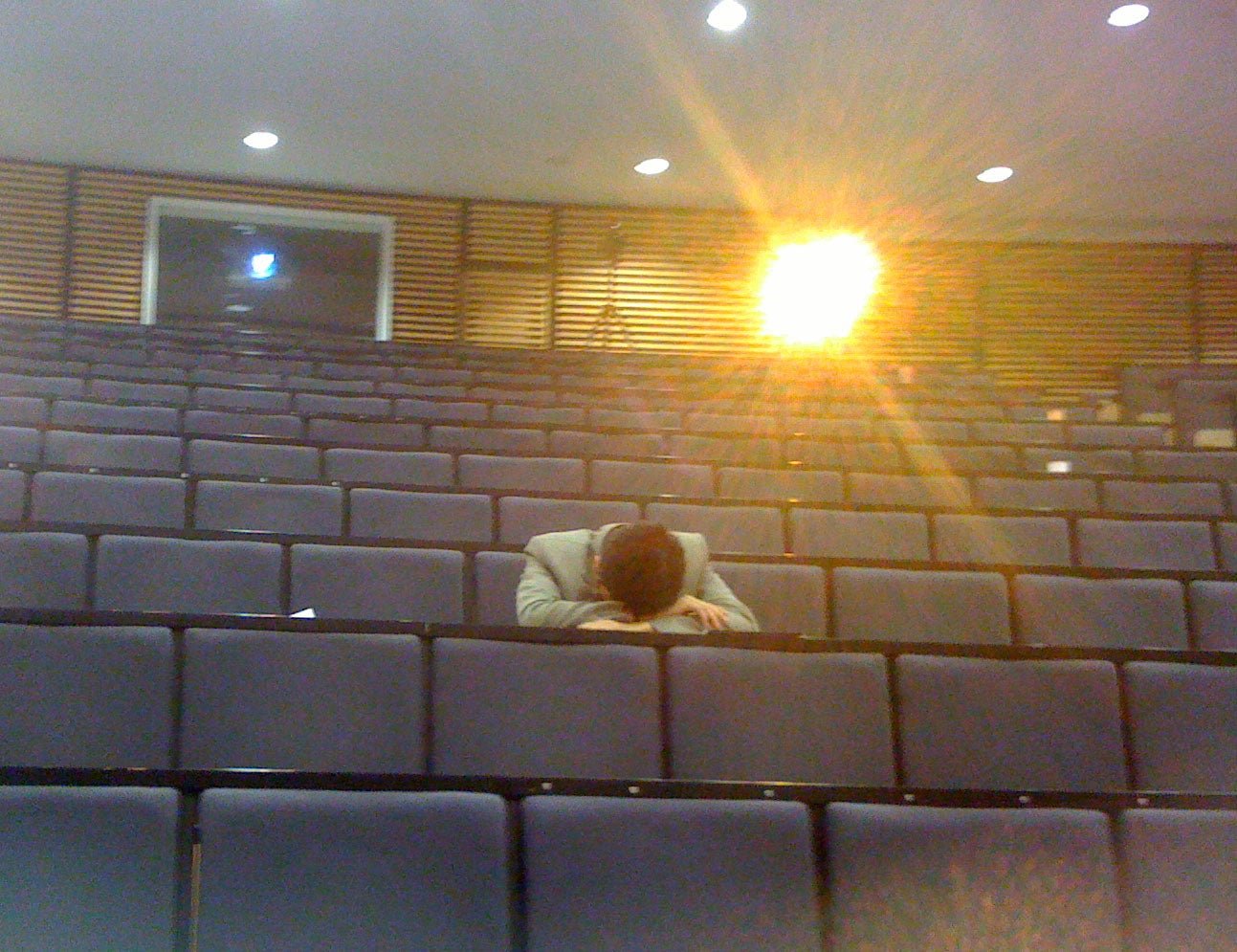I once tried to cheat sleep, and for a year I succeeded
In the summer of 2009, I was finishing the first—and toughest—year of my doctorate. To help me get through it, while I brewed chemicals in test tubes during the day, I was also planning a crazy experiment to cheat sleep.


In the summer of 2009, I was finishing the first—and toughest—year of my doctorate. To help me get through it, while I brewed chemicals in test tubes during the day, I was also planning a crazy experiment to cheat sleep.
As any good scientist would, I referred to past studies, recorded data, and discussed notes with some of my colleagues. Although the sample size was just one—and, obviously, biased—I was going to end up learning a great deal about an activity that we spend nearly a third of our life doing.
With looming deadlines and an upcoming thesis defense, I was determined to find more hours to fit in work and study. The answer came from reading about the famous American inventor Buckminster Fuller, who, Time reported in 1943, spent two years sleeping only two hours a day.
Fuller’s short dreams
The method to achieving what seemed like a superhuman feat was called the Dymaxion sleeping schedule: four naps of 30 minutes taken every six hours. Much of Fuller’s inventions were labeled “Dymaxion,” which is a portmanteau of dynamic, maximum, and tension, and I was certainly inspired to live like a great man once did.
When I started reading the scientific literature on the topic, I was surprised by how little we know about sleep. And the little we can explain comes from studying the effects of the absence of sleep. The average duration of a night’s sleep has been declining in recent years. In the US more than a third of the population gets less than seven hours of sleep in the day, and in the UK a similar proportion gets away with less than six hours.
Not sleeping properly causes problems, so we say that sleep is essential to many functions such as memory and cognition. But why we sleep and what ill-effect sleep deprivation may have remain poorly understood.
That lack of knowledge, however, hasn’t stopped people from experimenting with sleep. My experiment began six years ago, and today there are many more online forums dedicated to discussions around what is now referred to as “polyphasic sleep.” People have scoured past examples, such as the life of Leonardo da Vinci, to develop new polyphasic schedules. Like the Dymaxion schedule, the general idea is to break the large chunk of sleep at night in to multiple naps and thus reduce the total time spent sleeping.

The experiment begins
I saw that there were risks to what I was about to try, but I was also really fed up with dealing with my frequent grogginess just because I didn’t sleep eight hours each night. I jumped into the experiment and told a few good friends to keep a close eye on me; if anything seemed awry I would stop.
At the time, I didn’t drink tea or coffee and I wasn’t sad about giving up alcohol. Both caffeine and alcohol affect sleep, and I wasn’t taking chances with something that was going to require so much effort.
For the sleep schedule to work, I needed places to nap. I had a few secret spots in my huge chemistry lab at Oxford University (far away from any chemicals, of course). Better still, I had access to a couch in my college nearby.
My Australian housemate Alex at the time wanted to tame sleep too and decided to join in. We set about imitating Fuller and decided to take 30-minute naps every six hours.
Problems began after 36 hours. I was finding it hard staying awake at night, and Alex wasn’t able to wake up in time after naps despite many alarms.
We were aware that difficulties were bound to arise, but we didn’t realize how bad sleep deprivation truly feels. Alex went back to being monophasic, but I was determined. To make it work, I changed to an easier sleep schedule: the Everyman, where I slept for 3.5 hours at night and took three 20-minute naps in the day.

After three weeks and a few more obstacles, I finally settled into the new schedule. I was getting 4.5 hours of sleep in total, which was just a little more than half the hours I used to sleep.
The extra time was proving to be a wonderful benefit: I finished my first-year thesis; successfully defended it; decided that after finishing my doctorate I didn’t want to be in academia for the rest of my life; got a chance to explore Oxford University’s wonderful offerings without sacrificing on lab time; started exploring other career options, including writing, which eventually led me to become a journalist.
There were other gains. I found myself waking up fully refreshed after a nap. Quite often, before the alarm began ringing. The best bit was that I was benefitting from that superb early-morning blank mind four times a day instead of just once.
Others who’ve tried polyphasic sleeping had mentioned similar benefits. But what really surprised me was that I had managed to do something that seemed impossible going in.
Wasting no sleep
Sleep expert Claudio Stampi explained in his 1992 book Why We Nap: Evolution, Chronobiology, and Functions of Polyphasic and Ultrashort Sleep that humans shouldn’t find it hard to adjust to a polyphasic schedule.

Many animals are known to be polyphasic sleepers, and our hunter-gatherer ancestors may have been too. But we don’t even need to go so far back in time to find examples of polyphasic humans.
As Roger Ekirch notes in At Day’s Close: A History of Nighttime, a segmented sleep pattern was common as recently as the 18th century.
Back then people often slept for four hours, then woke up for an hour or two before going back to bed for another four hours. In the period they were awake at night, people smoked, had sex, and even visited neighbors. It was the advent of night-time lighting that allowed us to squeeze in more awake time doing things and made people adapt to what is today’s monophasic sleep.
Sleep to dream
A few decades ago, Stampi ran a polyphasic-sleep study to find out what happens to the brain under such circumstances. With the help of electric probes attached to a willing participant’s skull, Stampi compared how normal sleep cycles adjust to polyphasic sleep.
We may not realize it, but monophasic sleep is broadly divided into three stages. The first stage is that of light sleep consisting of rapid theta waves. The second stage is that of deep sleep characterized by slow delta waves. And finally, the last stage when we dream can be spotted with the help of rapid eye movements (REM).
During a night’s sleep, these three stages repeat in a cyclic manner over 90 to 200 minutes. But Stampi’s subject, who had adapted to taking six 30-minute naps per day, known as the Uberman schedule, seemed to have broken down those stages to fit them in during his short naps. In some naps he was in the first stage or the second stage, and in others he experienced REM.
Among the three phases, we understand REM’s role the best. It is believed to be key to learning and forming memories. People taught a skill and deprived of REM sleep, were not able to recall what they had learned. However, Stampi noted that the various stages of sleep were experienced in the same proportions in polyphasic sleeping, as the subject experienced them during monophasic sleeping, indicating that all stages were important.
I couldn’t find a scientific study on the sleep cycles in an Everyman schedule, but I noted that during at least one or two of my daily naps I experienced dreams, which are a sign of entering REM sleep. So it meant that I was probably directly entering the very last stage of monophasic sleep in a short nap.
And sometimes these dreams were lucid. In them, I was aware that I was dreaming and sometimes I was able to make conscious decisions in the dream. For instance, once after a long session of Assassins’ Creed, I found myself in a lucid dream where I was present in the virtual world of the video game. Though there were no people around to kill or interact with, I was able to choose which direction I wanted to go next to explore this world that I had come to know well from spending hours in front of a screen.
There are scientific explanations for why such dreams occur. But there remains skepticism because there is no way to test what are, by definition, self-reported observations.
Developing habits
To keep up this crazy sleep schedule, I always needed a good reason to wake up the next morning after my 3.5-hour nighttime sleep. So before I went to bed, I reviewed the day gone past and planned what I would do the next day. I’ve carried on with this habit, and it serves me well even today.
The hardest part, after the initial three weeks of adjusting to the schedule was keeping up with socializing. The world is monophasic and students in universities love alcohol. I sometimes avoided events if they clashed with my naptime, or I often left parties early so that I could keep living my polyphasic life.

But the Everyman schedule was reasonably flexible. Some days when I missed a nap, I simply slept a little more at night. There were also days when I couldn’t manage a single nap, but it didn’t seem to affect me very much the next day.
To the surprise of many, and even myself, I had managed to be on the polyphasic schedule for more than a year. But then came a conference where for a week I could not get a single nap. It was unsettling but I was sure I would be able to get back to sleeping polyphasic without too much trouble.
I was wrong. When I tried to get back into the schedule, I couldn’t find the motivation to do it; I didn’t have the same urgent goals that I had had a year ago. So I returned to sleeping like an average human.
Doing it again
Five years on, I carry a few napping skills from my experiment. I can nap anywhere (as long as I have ear plugs to block noise and I’m not caffeinated). I use naps to clear my head, and I haven’t found a better solution for doing that.
The experiment also taught me that I should respect sleep. Stretching myself to the limits gave me a deeper understanding of how crucial this activity is to our life.
Would I do it again? Perhaps, if I can find enough motivation for a large, well-defined project, such as writing a book. But I won’t do it for more than a few months, because there is a biological purpose of sleep that has only become clear in the last few years.
All the cells in our body require nutrients and produce waste. Blood vessels supply these nutrients throughout the body, and lymphatic vessels collect the waste from all parts of the body except the brain.
That waste, recent studies have shown, is cleared by the cerebrospinal fluid, which acts like the lymphatic system but does the job more effectively in the tight space inside the skull. What is more important, however, is that this waste clearance only happens while sleeping.
This is the most compelling answer to the question why sleep is so important to the normal functioning of the brain. Until I see studies that say that a polyphasic pattern, does not affect this waste clearance system, I won’t be returning to polyphasic sleeping on a long-term basis. But I don’t regret the experiment I ran fueled with my youthful spirit.